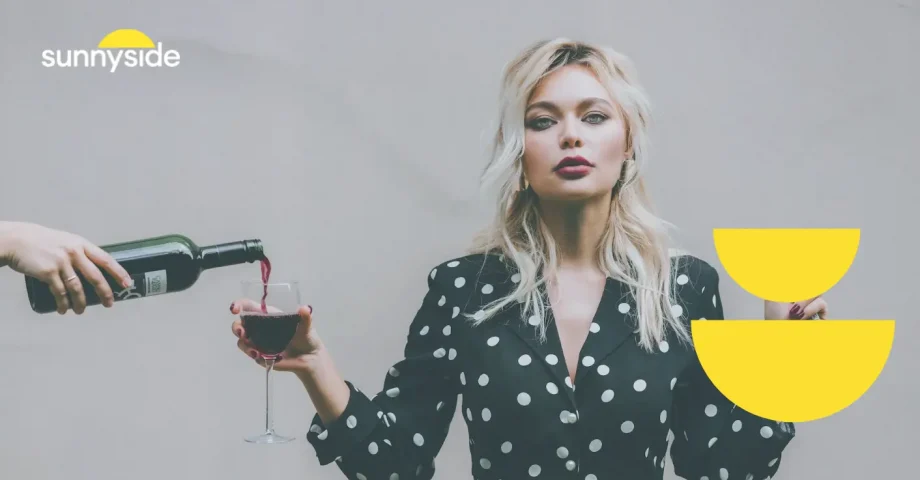Heavy drinking signals an unhealthy relationship with alcohol.
This relationship often sours slowly, making it difficult to pinpoint when you’ve crossed the line from moderate drinking to something more problematic.
You might consider yourself a social drinker. But say you start reaching for a drink to manage stress, or when you have downtime. The drinks add up. Soon these extra drinks become a daily habit. Then your personal and professional lives start to suffer. You get the picture.
The good news is heavy drinking doesn’t always mean you’re powerless over alcohol. In this article, we’ll explore warning signs of heavy drinking and actionable tips for regaining a healthier relationship with alcohol.
What is Heavy Drinking?
Heavy drinking is a threat to your physical and mental health.
The CDC defines heavy or excessive drinking as consuming 8 or more drinks per week for a woman or 15 or more drinks per week for a man. These numbers are one drink higher than the CDC standard for “moderate” drinking. [1]
The COVID pandemic led to a spike in heavy drinking, and many are still suffering the side effects. George Koob, director of the National Institute on Alcohol Abuse and Alcoholism (NIAAA), estimates “25% of people drank more than usual.” [2]
“Drinking more than usual” isn’t the same as heavy drinking. But since “deaths involving alcohol jumped 25.5% between 2019 to 2020,” much of it was heavy or excessive. [3]
Heavy drinking vs. binge drinking
It’s easy to confuse heavy drinking with binge drinking, though they’re related. Women binge drink when they consume 4+ drinks within 2 hours. For men, the threshold is 5+ drinks.
Both are unhealthy. And if you binge drink repeatedly, there’s a decent chance you’re a heavy drinker.
Signs You May Be a Heavy Drinker
Heavy drinking can affect both you and those around you. So it’s important to recognize when your alcohol use has reached this point. Here are some signs to look for:
1. Your alcohol consumption meets CDC benchmarks for heavy drinking.
An obvious sign, but it might be less obvious if your 8 or 15 weekly drinks doesn’t seem to impact your daily routine. You might still be able to function at work and at home.
Your ability to function is due to an increase in your alcohol tolerance. As you drink more, your body acclimates to the alcohol over time. You might not feel the effects of alcohol now, but it’s still harming you in ways you’ll feel down the road.
The American Psychiatric Association’s DSM-5 guide includes several tolerance-related questions, such as “Had to drink much more than you once did to get the effect you want?” [4]
The more times you answer yes to the DSM-5’s questions, the more likely you are to have an alcohol use disorder.
2. You cancel or miss enjoyable activities because of drinking.
Heavy drinking saps your energy, which means you’ll be less able to take part in healthy activities you used to find enjoyable.
Maybe drinking too much on Fridays makes you miss your Saturday morning spin class more often. Or you start skipping your Wednesday night book club because you’d rather stay home and drink.
These social gatherings are critical to your sense of well-being. Heavy drinking isolates you, which can lead to depression. You might drink more to compensate, leading to even heavier drinking. A vicious cycle.
3. You experience blackouts and hangovers more frequently.
Heavy drinking can lead to behaviors you’ll regret later, like drunk driving or risky sex. And the alcohol blackouts heavy drinking also causes can make you forget these behaviors ever happened. Plus you’ll feel hungover the next day and less able to cope with any fallout.
One blackout is bad enough. But if you can start counting your blackouts or hangovers from the past several weeks, there’s a good chance you’re drinking heavily.
4. You have several drinking triggers.
It’s one thing to have a single drink after a particularly stressful day. It’s something else entirely to consume alcohol whenever you experience stress, when bored, when socializing, or to celebrate something big or small.
These drinks add up, and before you know it, you’re in heavy drinking territory.
Here’s 30+ hacks to keep your drinking triggers at bay
Effects of Heavy Drinking
If heavy drinking goes unchecked, it can lead to serious health problems, not to mention your career and relationships. Here’s a rundown:
A rise in irritability, even violence
Alcohol “produces both stimulant and sedating effects in humans,” notes the National Institutes of Health. So it’s no surprise drinking causes mood swings. [5]
Heavy drinking, unfortunately, tends to swing moods in a negative direction. Numerous studies have shown that heavy drinking “leads to an inability to properly perceive and process information from the environment [and] interpret social cues.” As a result “there is an increased likelihood of experiencing…irritability.” [6]
A heavy drinker might perceive a harmless offhand comment or look as an insult, resulting in irritability or worse. In the worst cases, this inability to process social cues, “especially for men, may contribute to aggression and violence.” [7]
You don’t need us to tell you what acts of violence can do to relationships and careers.
Long-term risk of liver disease, among other problems
By the time alcohol-related liver disease becomes a noticeable problem, it’s often too late to reverse it. Heavy drinkers are most likely to experience this unpleasant surprise.
Cirrhosis is one of the sneakiest diseases. According to the Mayo Clinic, “While patients with early cirrhosis may not have any symptoms, this condition tends to progress and significantly damage the liver before it’s detected.” Liver transplants are often the only resort at this point.
The Mayo Clinic also cites heart disease, breast, and digestive tract cancer as “alcohol-related chronic conditions.” [8]
Maintaining a healthy liver starts with practicing mindful drinking. Here’s 6 ways to do it.
Severe anxiety and depression
After one drink, you probably feel great. That’s because of quick hits of GABA and dopamine. GABA, or gamma-aminobutyric acid, is a neurotransmitter that functions like a sedative. Dopamine is a pleasure-inducing neurotransmitter. [9]
The more you drink, the more the impact of GABA, dopamine, and dopamine’s sibling serotonin, wears off. So if you drink to relieve anxiety and depression, you’ll drink more in an attempt to “reactivate” these chemicals. Then you run the risk of blackouts and other problems.
Remember too alcohol is a depressant. So even if you don’t suffer from anxiety and depression, heavy drinking can cause these conditions to take hold.
Financial strain
Alcohol has a price tag. And with inflation straining consumer budgets, heavy drinking can make your bank account suffer as much as your body. [10]
According to data from the US Bureau of Labor Statistics, “beer prices rose 5.9% in the 12 months through April 2023, and are up 72% since the year 2000.” [11]
Not to mention the added stress of financial difficulties can compound your desire to drink, further draining your savings.
How to Manage Heavy Drinking
If you’re a heavy drinker, it’s tempting to quit cold turkey to start minimizing the side effects. This solution works for many drinkers, but not for all. Another strategy is to reduce your drinking slowly, setting manageable daily goals that boost your confidence when you achieve them.
Follow these tips to start your journey back to wellness.
Seek out a community for support.
Rarely can a heavy drinker start consuming less alcohol without support from a like-minded individual or group. While it’s relatively easy to find a group, the more difficult part is admitting out loud you have an unhealthy relationship with alcohol.
Here’s three communities that try to minimize the shame associated with heavy drinking.
Alcoholics Anonymous (AA)
If you want to explore total abstinence as a solution, start with AA. They pioneered the idea of drinkers supporting each other in the struggle for sobriety. But does it work?
Stanford Medical School professor Keith Humphreys learned in 2020 that AA is 60% more effective than other alcohol-related interventions. Why? “AA works because it’s based on social interaction,” Humphreys concluded. “Members give one another emotional support as well as practical tips to refrain from drinking.”
But if you learn that total abstinence isn’t for you, AA becomes less supportive. The good news is groups exist that support moderate or mindful consumption.
Moderation Management
Moderation Management (MM) offers support groups like AA. The difference is MM doesn’t hold up total abstinence as the ideal for every heavy drinker (or any drinker).
MM does recommend a 30-day period of abstinence as a way of “re-orienting” yourself to alcohol consumption. But it’s not required. The goal is simply for each participant to figure out what recovery looks like for them.
MM mainly offers virtual meetings.
Sunnyside
Imagine having an urge to drink and at the same moment, the option to grab your phone and manage that urge with the help of a supportive community.
The Sunnyside app does exactly that. It grants members access to a community with the shared goal of building healthier drinking habits. The community helps drinkers in the following ways:
- Daily reflections that build confidence and mindfulness around your goal to drink less.
- Access to certified coaches to guide you.
- The ability to get and offer encouragement from and to those who are struggling.
The Sunnyside app community is a judgment-free zone. The community treats failing to meet weekly goals as an opportunity for learning and reflection, not shame and self-hatred.
Talk to a medical professional.
Heavy drinking can be a sign of psychological and/or physical dependence on alcohol. And while a supportive community and more exercise might dent the psychological dependence, they are often not enough.
Medical professionals should be able to get to the heart of why you’re drinking heavily and give you personalized treatment. Their guidance might take one or both of these approaches:
- Cognitive behavioral therapy (CBT). You might drink heavily because of incorrect thoughts about yourself and the world around you. You might wrongly think you’re “worthless,” which can fuel depression and the urge to drink to compensate. [12]
- Naltrexone. This prescription medication “alters dopamine release following alcohol use.” The result? Drinking is not as rewarding or pleasurable. Cravings decrease. [13]
Take stock of your drinking triggers.
Urges to drink rarely happen in a vacuum. There’s usually a trigger that makes you want to reach for that beer or glass or wine.
Both your support group and medical practitioner will help you learn to recognize drinking triggers and deal with them in the moment. Once you identify these triggers, you’ll have more space to decide to do something other than drink. Here’s a few examples:
- If socializing is a trigger, learn to order a non-alcoholic cocktail when out with friends. Or plan a movie night instead of going to a bar.
- Meet the trigger of stress by going for a walk around the block, not walking to the kitchen for a drink.
Heavy drinkers likely have multiple triggers. Focus on one now, and once you master it, move on to another. You’ll see your well-being improve gradually.
Read this guide to help identify your drinking triggers.
Track your number of drinks on a daily basis.
Tracking daily drinks is part of mindful drinking, an essential part of restoring a healthy relationship with alcohol.
Before you can start tracking daily drinks you need a few things:
- Your current number of weekly drinks, based on CDC guidelines.
- A drinking goal, such as reducing your weekly drinks from 15 to 10.
- An app like Sunnyside, which both reminds you to log drinks and lets you log them quickly and easily.
How is this mindful drinking? By pausing each day to record your drinks, you can also in that moment assess your triggers, plan the next day, and consult the community if you stumble.
Use Sunnyside to Target Heavy Drinking
If you’re a heavy drinker, you deserve credit for having the courage to tackle this problem.
But let’s not mince words. Heavy drinking can seriously compromise the quality of your life. You’ll need help confronting and limiting it, which is why you should partner with Sunnyside.
Between psychiatrist appointments and group meetings, Sunnyside will help keep you motivated, without judgment, as you learn to drink less. All you need to do is complete this 3-minute quiz to get started.
[1] cdc.gov/chronicdisease/resources/publications/factsheets/alcohol.htm
[2] covid19.nih.gov/news-and-stories/risky-drinking-alcohol-use-epidemic-inside-covid-19-pandemic
[3] niaaa.nih.gov/news-events/research-update/deaths-involving-alcohol-increased-during-covid-19-pandemic
[4] Elvig SK, McGinn MA, Smith C, Arends MA, Koob GF, Vendruscolo LF. Tolerance to alcohol: A critical yet understudied factor in alcohol addiction. Pharmacol Biochem Behav. 2021 May;204:173155.
https://www.ncbi.nlm.nih.gov/pmc/articles/PMC8917511/
[5] Hendler RA, Ramchandani VA, Gilman J, Hommer DW. Stimulant and sedative effects of alcohol. Curr Top Behav Neurosci. 2013;13:489-509.
https://pubmed.ncbi.nlm.nih.gov/21560041/
[6] Godlaski AJ, Giancola PR. Executive functioning, irritability, and alcohol-related aggression. Psychol Addict Behav. 2009 Sep;23(3):391-403.
https://www.ncbi.nlm.nih.gov/pmc/articles/PMC2750093/
[7] https://neurosciencenews.com/alcohol-men-facial-emotions-19168/
[8] mayoclinichealthsystem.org/hometown-health/speaking-of-health/effects-of-alcohol-on-your-health-and-liver
[9] sciencedirect.com/science/article/abs/pii/S0006295204005453
[10] https://www2.deloitte.com/xe/en/insights/economy/spotlight/rising-inflation-poses-risks-for-consumer-spending.html
[11] https://www.bls.gov/news.release/cpi.htm
[12] https://www.apa.org/ptsd-guideline/patients-and-families/cognitive-behavioral
[13] https://ajp.psychiatryonline.org/doi/10.1176/appi.ajp.20220821




